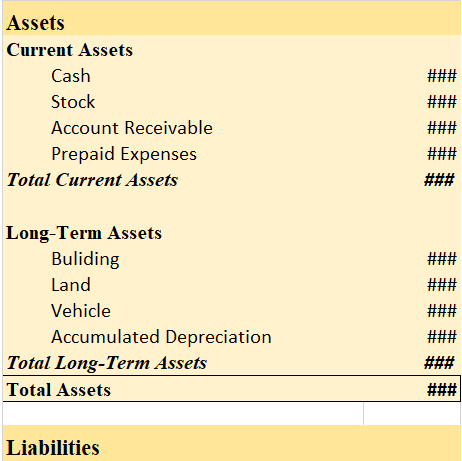A. Cash Book B. Statement C. Journal D. None of These
No, the building is not a current asset. Explanation Current assets are those in a business that is reasonably expected to be sold, consumed, cashed, or exhausted within one year of accounting through normal day-to-day business operations. Examples: Cash and cash equivalent, stock, liquid assets, etRead more
No, the building is not a current asset.
Explanation
Current assets are those in a business that is reasonably expected to be sold, consumed, cashed, or exhausted within one year of accounting through normal day-to-day business operations.
Examples: Cash and cash equivalent, stock, liquid assets, etc.
The building is expected to have a valuable life for more than a year and is bought for a longer term by a company. The building is a fixed asset/non-current asset, those assets which are bought by the company for a long term and aren’t supposed to be consumed within just one accounting year.
In order to understand it more clearly, let’s see the two types of assets in the classification of the assets on the basis of convertibility:
In the classification of the assets on the basis of their convertibility, they are classified either as current assets or fixed assets. Also referred to as current assets/ non-current assets or short-term/ long-term assets.
- Current Assets – As explained above, those assets in a business that is reasonably expected to be sold, consumed, cashed, or exhausted within one year of accounting.
- Fixed Assets – Those assets which are not likely to be converted into cash quickly and are bought by the business for a long term.
Building in the balance sheet
Let us take a look at the balance sheet’s asset side and see where building and current assets are shown
Balance Sheet (for the year ending…)

As we can see, the building is shown on the long-term assets side and not in the current assets.
Therefore, the building is not a current asset.
See less

The correct option is A) Cash book let's understand what is petty cash book: A petty cash book is a cash book maintained to record petty expenses. Petty expenses, mean small or minute expenses for which the payment is made in coins or a few notes or which are smaller denominations like tea or coffeeRead more
The correct option is A) Cash book
let’s understand what is petty cash book:
Generally, the petty cashbook is prepared as per the Imprest system. As per the Imprest system, the petty expenses for a period (month or week) are estimated and a fixed amount is given to the petty cashier to spend for that period.
At the end of the period, the petty cashier sends the details to the chief cashier and he is reimbursed the amount spent. In this way, the debit balance of the petty cashbook always remains the same.
The petty cash book has two columns in which
Balance of Petty cash book
The balance of petty cash book is never closed and their balances are carried forward to the next accounting period which is considered one of the most significant qualities of an asset whereas Income doesn’t have any opening balance and their balances get closed at the end of every accounting year.
A petty cash book is placed under the head current asset in the balance sheet. The Closing Balance of the petty cash book is computed by deducting Total expenditure from the Total cash receipt (as received from the head cashier).
Format for petty cash book
Only small denominations are recorded in the petty cash book. It varies with the type, quantity, and need of a business. It involves cash and checks.
Conclusion
A simple petty cash book is a type of cash book because it records the small expenses which involve small transactions in the ordinary daily business.
A petty cash book is not as important as an income statement, balance sheet, or trail balance it doesn’t measure the accuracy of accounts so it is not treated as a statement.
No journal entries are made in the books of accounts while spending or purchasing using a petty cash book so, it is not treated as a journal.
See less